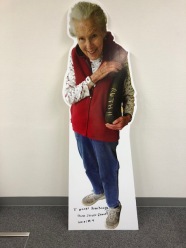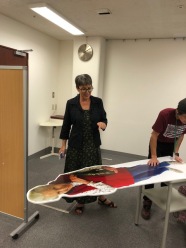
Dover Publications edition of My Father’s Dragon
Every once in a while, being a translator of Japanese children’s books puts you in the best place to learn about children’s books of another country. Such was the case when Deborah Iwabuchi agreed to translate the only biography (in Japanese) of Ruth Stiles Gannett, author of My Father’s Dragon—and assist Ms. Gannett on her summer 2018 visit to Japan.
By Deborah Iwabuchi, Maebashi, Japan
First of all, a little background for how this came about! In 2010, Ruth Stiles Gannett came to Japan at the invitation of a Japanese newspaper. The well-known author, aged 87 at the time, captured the heart of Akie Maezawa, the interpreter assigned to accompany Ms. Gannett on school visits. Maezawa subsequently made a trip to Ithaca, New York, to visit and talk to Ms. Gannett.
The result was the only book-length biography of the author of the Elmer books, The Woman who Wrote My Father’s Dragon, Ruth S. Gannett (published in Japanese by Fukuinkan Shoten).
I met Maezawa—let’s call her Aki, as Ms. Gannett does—when she attended an SCBWI Japan Translation Day 2016 in search of a translator for her book, which has been well-received by Elmer fans in Japan.

The Japanese biography of Ruth Stiles Gannett, written by Akie Maezawa, published by Fukuinkan Shoten
One look at the cover, with a photo of a smiling Ruth Gannett holding a huge stuffed Boris doll surrounded by a sunny background of white and yellow stripes, and I was sold! (That’s another story, and yes we are looking for a publisher.) Meanwhile, Aki became involved with Puk, a Japanese puppet theater company. Puk was planning a production of My Father’s Dragon and was facing various problems with copyrights. Aki became their point person to garner support from the author of the book. After the production got the go-ahead, the people at Puk decided they wanted more than anything to have Ruth Gannett in Japan to see it. The author, 94, had recently had an accident that left her bedridden, but in typical style, she miraculously recovered and, accompanied by two of her seven daughters, she made the trip to Japan.
Ms. Gannett and her daughters made it safely to Tokyo at the end of July 2018 and, among side trips to Hakone and other places, attended a Puk performance, much to the joy of the audience and cast. On August 4, a separate event took place at Kinokuniya Hall in Shinjuku: a panel discussion by four people closely connected to the Elmer books in Japan, followed by Q-and-A session with Ms. Gannett. To my great pleasure, Aki asked me to help interpret the event for the three guests of honor.
On the evening of August 4, Ms. Gannett and her lovely daughters, Louise Kahn and Margaret (Peggy) Crone, arrived wreathed in smiles and ready for the big evening. The looks on the audience members’ faces as we all entered the packed Kinokuniya Hall told the story of how much everyone loved the books: My Father’s Dragon, Elmer and the Dragon, and The Dragons of Blueland. Many families in the room had three generations present, eager to see a beloved author. Feeling like a celebrity myself, I settled with Ms. Gannett’s family in seats about halfway back in the hall, until it was time for Ms. Gannett to go onstage.
Above: Ms. Gannett, her daughters, and a cutout of Ms. Gannett backstage at Kinokuniya Hall.
The first half of the program was a panel discussion with Mr. Shibasaki, the director of the Puk production, Aki Maezawa, Tetsuta Watanabe—son of the late Shigeo Watanabe who translated the Elmer books—and Tomoko Shirota, a member of JBBY who has successfully used My Father’s Dragon for twenty-four years in library programs to get children reading. The initial talks by these four were delightfully full of episodes about Ruth Stiles Gannett, Elmer Elevator, the puppet production and children and adults who have read and loved the books over the years. I wish I had the room to include all the stories here.

Japanese edition of My Father’s Dragon, translated by Shigeo Watanabe, published by Fukuinkan Shoten
Since this is a translators’ blog, let me talk about Shigeo Watanabe, as described by his son Tetsuta, who traveled all the way from Australia to be with Ms. Gannett that evening. The elder Watanabe was a member of the ISUMI group: writers and translators who met regularly in the years following the end of World War II to discuss the direction in which they hoped to take children’s literature in Japan. Watanabe had first read My Father’s Dragon in 1952, just four years after its publication in the US. He and the ISUMI group eventually chose the book as one they wanted Japanese children to read. In Tetsuta’s words, “They were looking for a book Japanese would enjoy, but probably not write.” My Father’s Dragon was published in Japanese as “Elmer’s Adventure” (Erumaa no boken) in 1964.
Tetsuta, a small child at the time, recalls his father ruminating over aspects of the book—things that would warm the cockles of a translator—such as the relationship of the two wild boars who make appearances throughout the story. Were they siblings? Friends? A married couple? He had to know so he could decide the type of language to use. Inverting parts of words as the excitable Mouse did in the English proved to be an easy task as Japanese syllables are easy to play with. Once the book was out, Watanabe, a young man with a family to support, kept careful records of the number of copies My Father’s Dragon sold, comparing it to Rieko Nakagawa’s Iya-iya-en, a bestselling Japanese book, which came out at about the same time. (Note: It turns out that Nakagawa and her son, Kanta, are both huge Elmer fans! Shirota told the rapt audience how young Kanta had begged his mother to use her publishing contacts to rewrite the book with his name in it and title it Kanta’s Adventure. The little boy only gave up his tearful pleas when Nakagawa explained about copyrights.)

Above: Tetsuta Watanabe and Akie Maezawa pose backstage; Ms. Gannett signs her autograph.
Shigeo Watanabe went on to become a prominent translator of children’s books. I have never read his Japanese translation of Elmer, but I’m sure he deserves his share of the credit for how the books have stood the test of time and remained consistently popular in Japan for the past half-century—as well as for the excitement in Kinokuniya Hall on August 4.
The second part of the program that evening was devoted to Ruth Stiles Gannett. Frail, but elegant and sure, she took the stage flanked by her daughter Louise, who assisted her mother with some responses (the interpreter’s interpreter) and me (the plain old Japanese-to-English interpreter). Aki, who knows Ms. Gannett well, took the job of summarizing and interpreting the author’s responses into Japanese. Ms. Gannett’s English was easy to understand and the audience was perfectly silent as they hung on every word, and remained captivated as they listened to the Japanese that came afterwards. Here are a few of the questions.

Anniversary edition of the Elmer trilogy
Why did you decide to write the books? I had been working at a ski lodge, the snow had melted and I had nothing to do. My parents were busy with their work, so I got busy writing! I did it mainly to entertain myself. I never intended to publish it until someone suggested it.
Why did you choose a dragon for Elmer to save? I was writing a book about my father, and I wanted him to save a creature that was large, strong and unusual.
Why did the dragon have yellow stripes? I drew a different picture of the dragon, and the stripes were the choice of my stepmother, Ruth Chrisman Gannett, who did all the illustrations in the book.
Why did you choose for Elmer to eat tangerines (mikan)? When I was young we got tangerines in the toes of our Christmas stockings. They weren’t available much before the Christmas season. Fruit like that was a rare treat for us.
What do you do every day? Oh not much, I like to read, get exercise, do yoga, bake bread and cookies . . . (note: there was more, but I can’t remember it all!).
Ms. Gannett had a question of her own that she mentioned several times during the short time I was with her. I’ll put it out there and would love to hear from anyone who has ideas on the subject so I can let her know. In publishing My Father’s Dragon, she intended it for middle graders to read, but she has found that in Japan it is overwhelmingly read to preschoolers, and she wonders why that is.
The two hours sped quickly by. Just before the evening ended we were joined on stage by Peggy and the Puk cast as the entire hall sang “Happy Birthday” to Ms. Gannett, who will be 95 on August 12. “Don’t forget!” Aki reminded the audience, “Her name is Ruth. Make sure to get the ‘r’ and the ‘th!’”

My selfie with Ruth Stiles Gannett. I worried that we would wear her out, but Ms. Gannett and her daughters were gracious and she had a beautiful smile for everyone! —D.I.





Posted by Ruth G. Kahn on May 9, 2020 at 6:15 am
Thank you very much for this lovely article. I enjoyed reading it and remembering the wonderful puppet show and people I met in Japan.
Posted by SCBWI Japan Translation Group on April 16, 2022 at 5:30 pm
Ruth! Thanks so much for reading this! It was one of the best days of my life. Deborah
Posted by Angela P on April 6, 2022 at 6:31 am
Great article!
This series is an all time favourite & was curious about the biography, if it was every translated into English, I would love to read it!
Posted by SCBWI Japan Translation Group on April 16, 2022 at 5:31 pm
Angela, thanks so much. Unfortunately it hasn’t found a publisher yet.
Posted by Tommy on February 10, 2023 at 6:50 am
Hi Deborah, I am a grad student a Simmons University doing a semester-long research project on the publishing history of My Father’s Dragon. If you are willing, I would LOVE to talk to you about your experience. Please let me know here if this is the case and I will give you my email. If not, no sweat! I know it’s a lot to ask. In any case, thank you so much for writing this blog post!
Posted by Michael Gannett on October 30, 2023 at 1:17 am
Tommy, Your semester-long research project on the publishing history of My Father’s Dragon should have been completed by now. Please contact me (Ruth’s oldest nephew) to review your work, please, at gannettm(at) gmail(dot) com. Michael
Posted by Michael Gannett on October 30, 2023 at 1:22 am
Ruth Stiles (Gannett) Kahn, my aunt, lives with dementia in assisted care in Massachusetts, having passed her 100th year in August.
Posted by SCBWI Japan Translation Group on October 31, 2023 at 12:48 pm
Dear Tommy and Michael, I’m so sorry I didn’t catch your comments and I’m sorry to hear Ruth is not doing well. Tommy, I hope you can contact Michael if you still need some help.
Posted by Michael Gannett on October 31, 2023 at 7:39 pm
I was simply curious, never having been involved with Ruth’s publishing. Neither has there been a group of devotees of Ruth’s work in the US, as in Japan… until recently. A Kansas City group are opening a museum March, 2024 which features a marvelous representation of Elmer’s and Boris’s world. It’s a shame a publisher for the biography was not found. A serious prompting of interest in Ruth-the-person by the very existence of a biography might well go hand in hand. Have Ruth’s daughters seen the manuscript? I would certainly love to read it. Charlotte, her oldest, might even wish to read it to her. Informationally, Ruth’s brother Michael had foursons. I was the first in 1943. -Michael